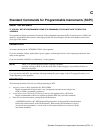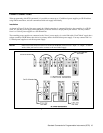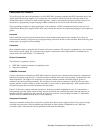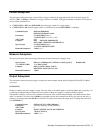
Standard Commands for Programmable Instruments (SCPI)
91
Description
This command causes the interface to set the OPC bit (bit 0) of the Standard Event Status register when the power supply
has completed all pending operations. (See
*ESE for the bit configuration of the Standard Event Status register.)
Pending operations are complete when:
♦
all previous commands have been executed
♦
any change in the output level caused by previous commands has been completed (completion of settling time, relay
bounce, etc.)
♦
no pending trigger level operations are set
*OPC does not prevent processing of subsequent commands but Bit 0 will not be set until all pending operations are
completed.
Command Syntax *OPC
*OPC?
Meaning and Type
Operation Complete
Device Status
Description
This query causes the interface to place an ASCII "1" in the Output Queue when all pending operations are completed.
Pending operations are as defined for *OPC. Unlike *OPC, *OPC? prevents processing of all subsequent commands.
*OPC? is intended to be used at the end of a command line so that the application program can then monitor the bus for
data until it receives the "1" from the power supply Output Queue.
Do not follow *OPC? with *TRG or GP-IB bus triggers. Such triggers sent after *OPC? will be prevented
from executing and will stop system operation. If this occurs, the only programmable way to restore
operation is by sending the power supply a GP-IB DC1 (Device Clear) command.
Query Syntax *OPC?
Returned Parameters <NR1>
ASCII 1 is placed in the Output Queue when the
power supply has completed operations.
*PSC
Meaning and Type
Power-on Status Clear
Device Initialization
Description
This command controls the automatic clearing at power turn on of:
♦ the Service Request Enable register
♦ the Standard Event Status Enable register


















